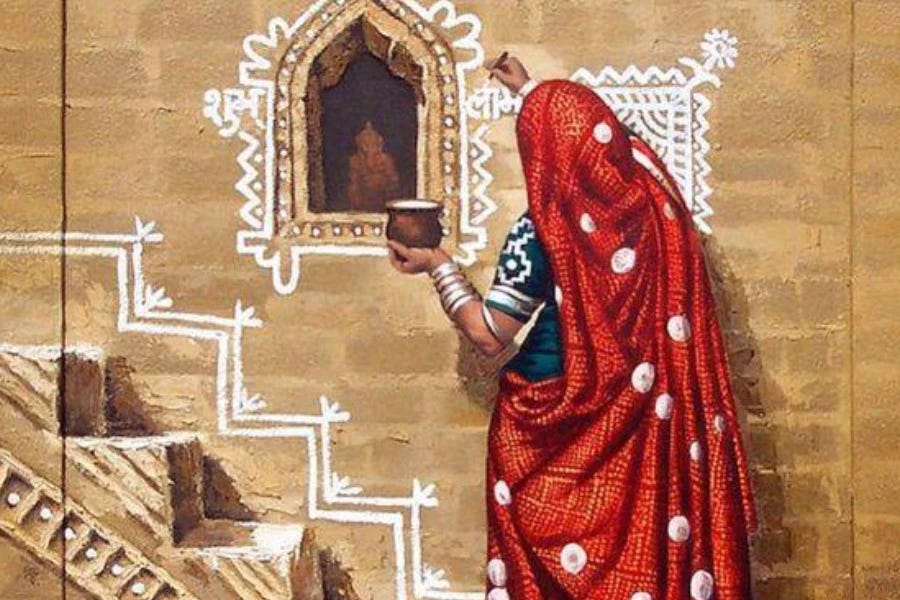The Female Force in the Handicraft Industry
Issue#7, Explore the pivotal role of women in global handicraft industry and how their craftsmanship drives the sector's growth
Since I started working in 2021, in many industries, it’s hard to miss the lack of women in the workforce. But what struck me as incredibly fascinating about the handicraft industry is that women aren’t just present - they’re at the very heart of it.
In fact, according to the Indian handicraft census, 56.13% of artisans are women. That’s something I don’t often see in other sectors. FASCINATING !!
So when I dive deeper into this industry I realise that handicrafts have been a part of human history for centuries, and it’s mostly women who have kept these traditions alive, passing down their skills through generations. In this edition, I’ll dive into how handicrafts are empowering women, and what we can do to encourage this growing industry so that more women are recognised for their work and are able to become skilled worker in demand.
Women Leading the Way? There's More to the Story…
For generations, women have not only been making handicrafts but also shaping the industry’s legacy. They’ve preserved traditional techniques and practices, ensuring their culture and heritage are carried forward. Well, data backs this up - globally, women make up 70% of the handicraft workforce, and in countries like India and Bangladesh, that number jumps to over 80%! While it’s an ancient trade, handicrafts today provide a modern lifeline, especially for women in rural areas where other economic opportunities are scarce. The craft economy has become a powerful engine for change, allowing women to gain financial independence, support their families, and improve their social standing within their communities.
But it’s not just about survival - women are leading the way in innovation too. From blending traditional designs with contemporary aesthetics to embracing digital platforms for selling their goods, women artisans are redefining what it means to be a creator in the 21st century. This REALLY excites me for the future of the handicraft industry, where women are not just seen as labourers but as entrepreneurs, creators, and decision-makers. In many cases, they’re already managing their own businesses, forming cooperatives, and negotiating contracts, laying the foundation to move from informal workers to contracted employees, with better wages and social protections.
The numbers speak for themselves: the United Nations estimates the global handicraft industry generates up to $32 billion annually, with women contributing a huge chunk of that revenue. As this sector grows, the potential for economic empowerment is vast. With increased access to training, resources, and markets, women artisans have the opportunity to not only sustain their livelihoods but to thrive in an increasingly global marketplace. This transformation is a testament to the resilience and creativity of women across the world - and it’s only the beginning.
So, How Does Handicraft Have Such a Strong Female Workforce?
So despite the booming success of the handicraft industry, it’s still largely informal and decentralised. I feel this worked as a boon and a bane for women contributors. Most artisans work from home or within local craft clusters. You’ll find women from various regions weaving stories into their art: from the intricate needlework of Chikankari to the vibrant patterns of Madhubani paintings.
The freedom to work from home is a game-changer for women, especially in patriarchal societies where opportunities are often limited. Handicrafts offer a way to break those barriers. Women’s involvement in this sector not only boosts their self-reliance but also fosters better access to education, healthcare, and creative expression.
Plus, handicrafts help prevent the mass migration of workers to cities, keeping local economies strong. Women artisans play a key role in maintaining their cultural identity, keeping traditional arts alive for future generations.
The Power of Tradition
Take the beautiful Mandana paintings from Rajasthan and Madhya Pradesh. These intricate designs, often created by women, are passed down from mothers to daughters. In places where traditional homes are disappearing, artists like Koshilya Devi and Vidya Devi Soni are reviving this ancient art, providing vocational training to keep these skills alive while creating new economic opportunities.
Similarly, the women weavers of Kumaon Valley are gaining global recognition for their stunning work with fabrics. Their textiles - shawls, stoles, and quilts - are rooted in tradition but have been adapted for a modern, urban audience.
What Can We Learn About Gender Equality from Handicrafts?
Despite all the progress, women still face barriers in the handicraft industry, from limited access to resources to deeply ingrained gender biases. But there are ways to overcome these challenges. Microfinance programs, for example, can help women start their own businesses. Mentorship and training programs are also essential for honing skills and navigating the industry.
It’s also about changing mindsets - raising awareness around gender equality and challenging the stereotypes that hold women back. Policymakers need to get involved, too, by creating policies that support women’s economic empowerment and protect their rights.
Market access is another key issue. Women artisans need better opportunities to showcase their work, both domestically and internationally, to ensure fair prices and grow their income.
In Conclusion
When I started drafting this edition of newsletter, I was in awe during my research around how this handicraft industry is truly women-led and empowering an industry of this sort would impact a huge chunk of women workers in various capacities.
The handicraft industry is more than just a creative outlet, it’s a pathway to social equality. It offers freedom, independence, and dignity, especially in a world where caste and gender often limit opportunities.
I truly believe in larger scheme of things through handicrafts, women can break free from societal constraints and build lives of their own choosing - becoming financially independent and confident in their craft. That’s the power of this industry, and it’s one more step toward a more equal world.





